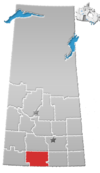Rural Municipality of Mankota No. 45
Mankota No. 45 | |
|---|---|
| Rural Municipality of Mankota No. 45 | |
 R.M. office in Mankota | |
 Location of the RM of Mankota No. 45 in Saskatchewan | |
| Coordinates: 49°19′08″N 107°01′23″W / 49.319°N 107.023°W[1] | |
| Country | Canada |
| Province | Saskatchewan |
| SARM division | 3 |
| Federal riding | Cypress Hills—Grasslands |
| Provincial riding | Wood River |
| Formed[2] | January 1, 1913 |
| Government | |
| • Reeve | Greg Zerr |
| • Governing body | RM of Mankota No. 45 Council |
| • Administrator | Tammi Baldock |
| • Office location | Mankota |
| Area (2016)[4] | |
| • Land | 1,696.35 km2 (654.96 sq mi) |
| Population (2016)[4] | |
| • Total | 292 |
| • Density | 0.2/km2 (0.5/sq mi) |
| Time zone | CST |
| • Summer (DST) | CST |
| Postal code | S0H 2W0 |
| Area code(s) | 306 and 639 |
| Highway(s) | Highway 18 Highway 19 Highway 611 |
| Point(s) of interest | Grasslands National Park |
The Rural Municipality of Mankota No. 45 (2016 population: 292) is a rural municipality (RM) in the Canadian province of Saskatchewan within SARM Division No. 3. Located in the southwest portion of the province, it is adjacent to the United States border, neighbouring Valley County and Phillips County in Montana.
History
[edit]The RM of Mankota No. 45 incorporated as a rural municipality on January 1, 1913.[2]
Geography
[edit]Communities and localities
[edit]The following urban municipalities are surrounded by the RM.
The following unincorporated communities are within the RM.
- Localities
Demographics
[edit]In the 2021 Census of Population conducted by Statistics Canada, the RM of Mankota No. 45 had a population of 289 living in 129 of its 158 total private dwellings, a change of -1% from its 2016 population of 292. With a land area of 1,693.17 km2 (653.74 sq mi), it had a population density of 0.2/km2 (0.4/sq mi) in 2021.[8]
In the 2016 Census of Population, the RM of Mankota No. 45 recorded a population of 292 living in 132 of its 154 total private dwellings, a -9.3% change from its 2011 population of 322. With a land area of 1,696.35 km2 (654.96 sq mi), it had a population density of 0.2/km2 (0.4/sq mi) in 2016.[4]
Government
[edit]The RM of Mankota No. 45 is governed by an elected municipal council and an appointed administrator that meets on the second Tuesday of every month.[3] The reeve of the RM is Greg Zerr while its administrator is Tammi Baldock.[3] The RM's office is located in Mankota.[3]
Transportation
[edit]See also
[edit]References
[edit]- ^ "Pre-packaged CSV files - CGN, Canada/Province/Territory (cgn_sk_csv_eng.zip)". Government of Canada. July 24, 2019. Retrieved May 23, 2020.
- ^ a b "Rural Municipality Incorporations (Alphabetical)". Saskatchewan Ministry of Municipal Affairs. Archived from the original on April 21, 2011. Retrieved May 9, 2020.
- ^ a b c d "Municipality Details: RM of Mankota No. 45". Government of Saskatchewan. Retrieved May 21, 2020.
- ^ a b c "Population and dwelling counts, for Canada, provinces and territories, and census subdivisions (municipalities), 2016 and 2011 censuses – 100% data (Saskatchewan)". Statistics Canada. February 8, 2017. Retrieved May 1, 2020.
- ^ "2019-2020 Rural Revenue Sharing Organized Hamlet Grant". Government of Saskatchewan. Retrieved May 4, 2020.[permanent dead link]
- ^ "Saskatchewan Census Population" (PDF). Saskatchewan Bureau of Statistics. Archived from the original (PDF) on September 24, 2015. Retrieved May 9, 2020.
- ^ "Saskatchewan Census Population". Saskatchewan Bureau of Statistics. Retrieved May 9, 2020.
- ^ "Population and dwelling counts: Canada, provinces and territories, census divisions and census subdivisions (municipalities), Saskatchewan". Statistics Canada. February 9, 2022. Retrieved April 13, 2022.


